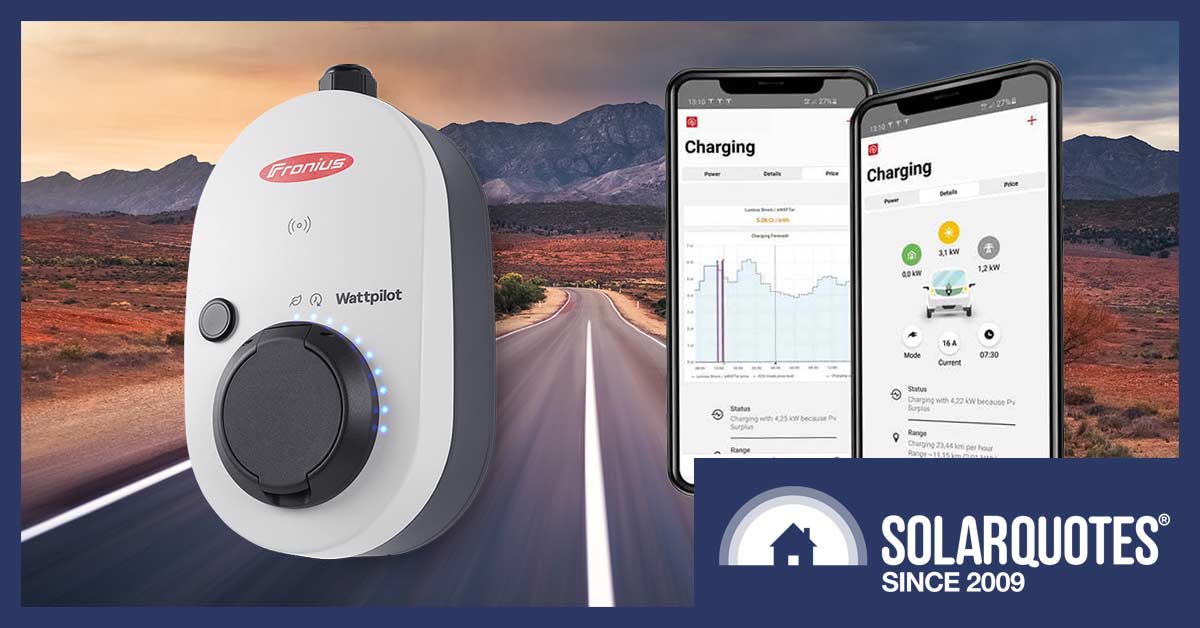
The Fronius Wattpilot finally launches in Australia
I have good news if you want to charge an electric vehicle with Austrian technology. Fronius Australia launched their Wattpilot EV charger last week. Last week we were told it would be available here “in a couple of weeks”. A surprisingly imprecise period of time, given they are Austrian.
Some major Wattpilot points are…
- There are three versions.
- 11 kW
- 22 kW
- 22 kW with a plug – so it’s portable
- All Wattpilots can be wired as single or 3-phase.
- Confusingly the 11 kW version will only charge at a maximum of 3.68 kW if it is on a single phase.
- If you only have single-phase you must buy the 22 kW version to charge at 7 kW
- The chargers can go as low as 1.38 kW – handy for scavenging surplus solar electricity.
- Most electric vehicles in Australia are limited to 16 kW AC or less.
- They can do smart solar charging if you have a Fronius solar inverter and smart meter.
- They are OCPP 1.6 compatible1.
- They come with an ID fob so only you can charge.
- You can buy up to 10 different ID fobs, allowing multiple users.
- The 22 kW version is around $1,800 not including installation.
- It does not come with a charging cable.
The Wattpilot only has a two-year warranty despite Fronius’ reputation for making reliable electronics. While this is similar to other EV chargers, it doesn’t make the Wattpilot’s warranty good. It simply means they all have shithouse warranties2. See my other post for a deep dive into the Wattpilot’s warranty.
I’ll explain the Wattpilot versions below. First, I’ll make fun of the name because I can’t help myself.

“Wattpilot?”
Before diving into the details, if you want to read up on EV chargers in general, I recommend checking out our EV Charger 101 Guide. It’s so good, UK charger company MyEnergi sent us a long ‘legal’ letter about it3.
Three Wattpilot Variants
The Wattpilot is far more restrained than COVID, as it only has three variants. This table from Fronius gives some of their tech specs:
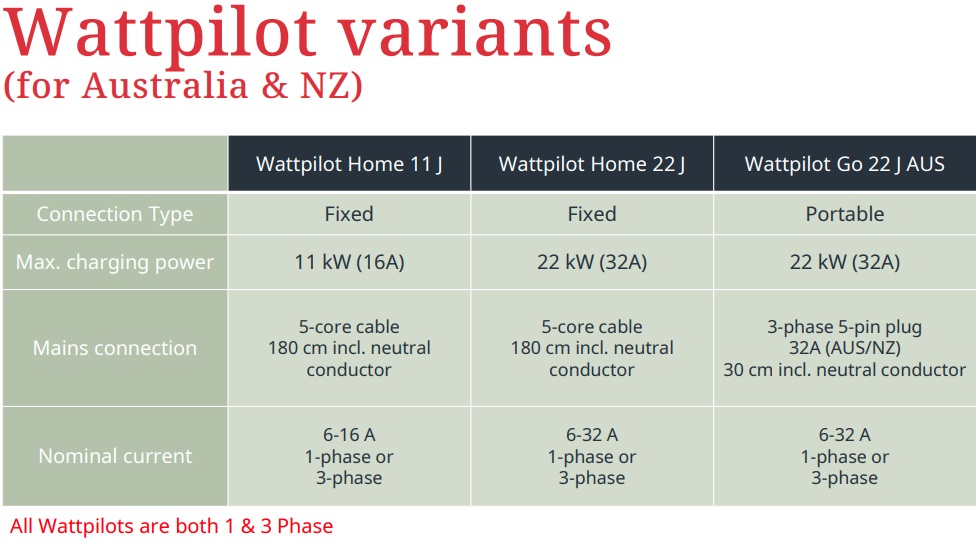
Slide: Fronius
If you understand what all the words in the above table mean, that’s great! But if you don’t have a clue, don’t worry. I’ll explain everything in terms even I can comprehend.
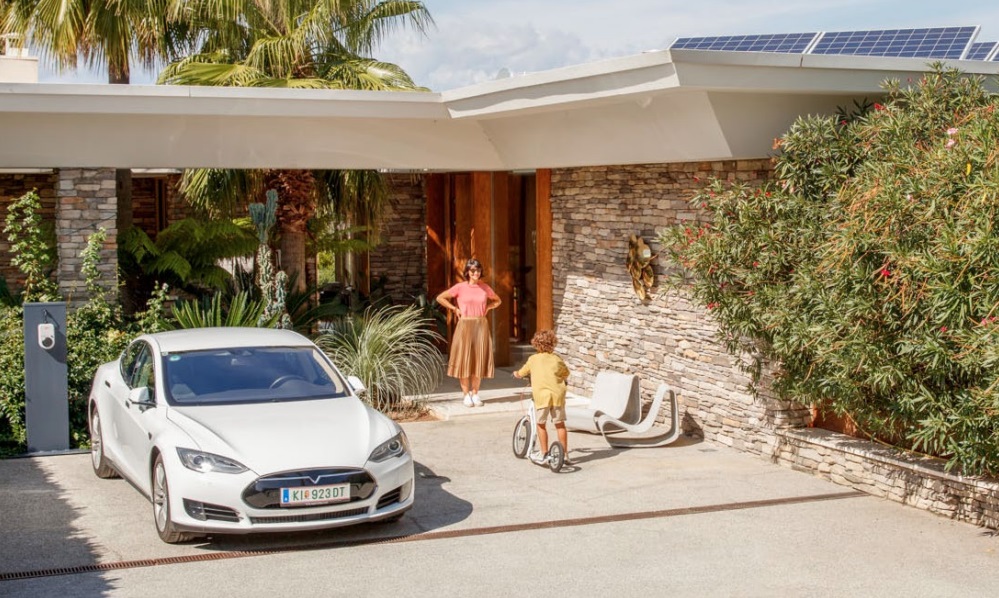
“Young man, don’t make me tell you again! Put the steering wheel back on the correct side of the car this instant!” Image: Fronius
Wattpilot Home 11J — 11 Kilowatts
The wimpiest version of Wattpilot is the ‘Home 11J’.
If you have single-phase this variant will only charge at a maximum of 3.68 kW.
That’s too slow. Do not buy this variant if you only have single-phase. Buy the 22 kW version instead.
It can supply 11 kW if wired to 3-phase, half what the other two can. But this often won’t be a drawback because there are many situations an EV can’t charge at 11 kW no matter which Wattpilot is used.
These include:
- Many electric vehicles can only charge at 11 kilowatts or less because they are limited by their onboard AC chargers4. (Note most electric cars can charge much faster if a large DC rapid charger is used — but you’ll have a hard time installing one of these at home.)
- Some homes may be limited in how much power they can reliably supply due to wiring or grid connection limits.
- The charger cable used can be a limiting factor. If you want to charge at more than 7.3 kW, you need a 3-phase cable as well as a 3-phase charger and, of course, a 3-phase supply.
If you have 3-phase power I recommend the 22 kW Wattpilot, even if your EV can only charge at 11 kW or less. There are a couple of reasons why:
- So you’ll be ready if you get a car that can charge faster in the future.
- A friend with a faster-charging EV may visit.
The advantage of the 11 kW Wattpilot is it’s likely to be a little cheaper. Normally, I’d recommend people be careful with their money, but if you can afford a new EV, you can afford a few hundred bucks extra for a 22 kW capable charger.
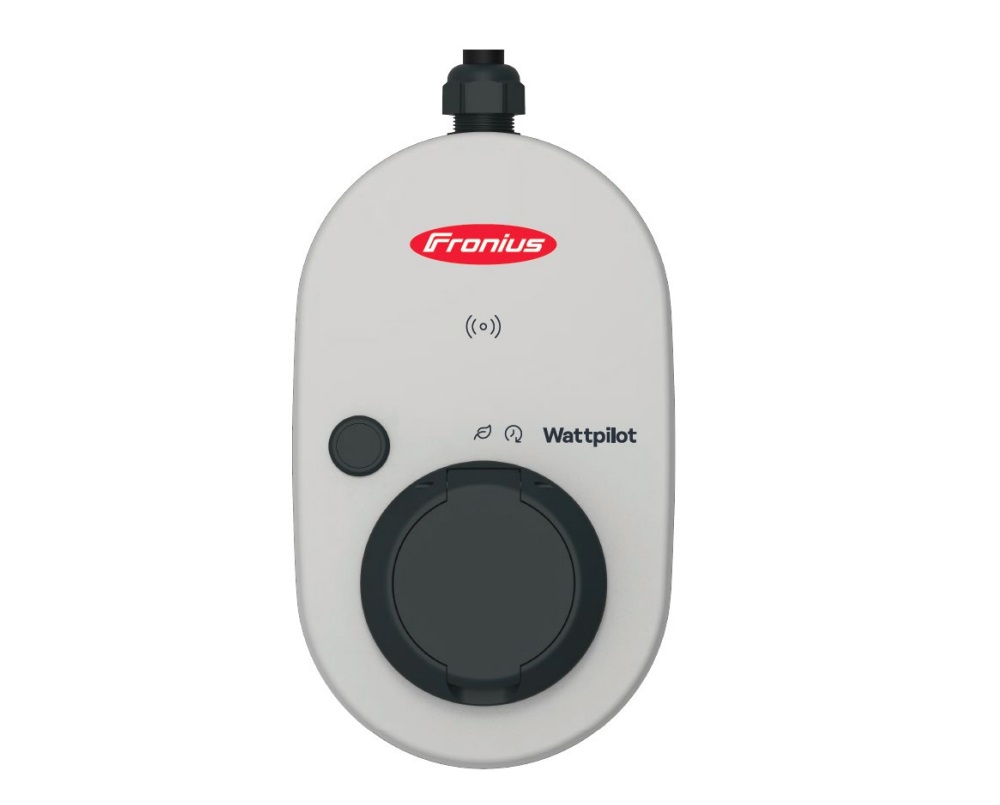
The Wattpilot is such a marvel of design it looks like a plastic tear shed by an Austrian robot god. Image: Fronius
Wattpilot Home 22J — 22 Kilowatts
The 22J can charge at 7.3 kW on single-phase and 22kW on 3-phase. But the only car I know of in Australia that can charge at 22 kW from an AC charger such as the Wattpilot Home 22J is the Renault Zoe.
This graph shows the max AC charge speeds of Australian EVs in km-added-per-hour.
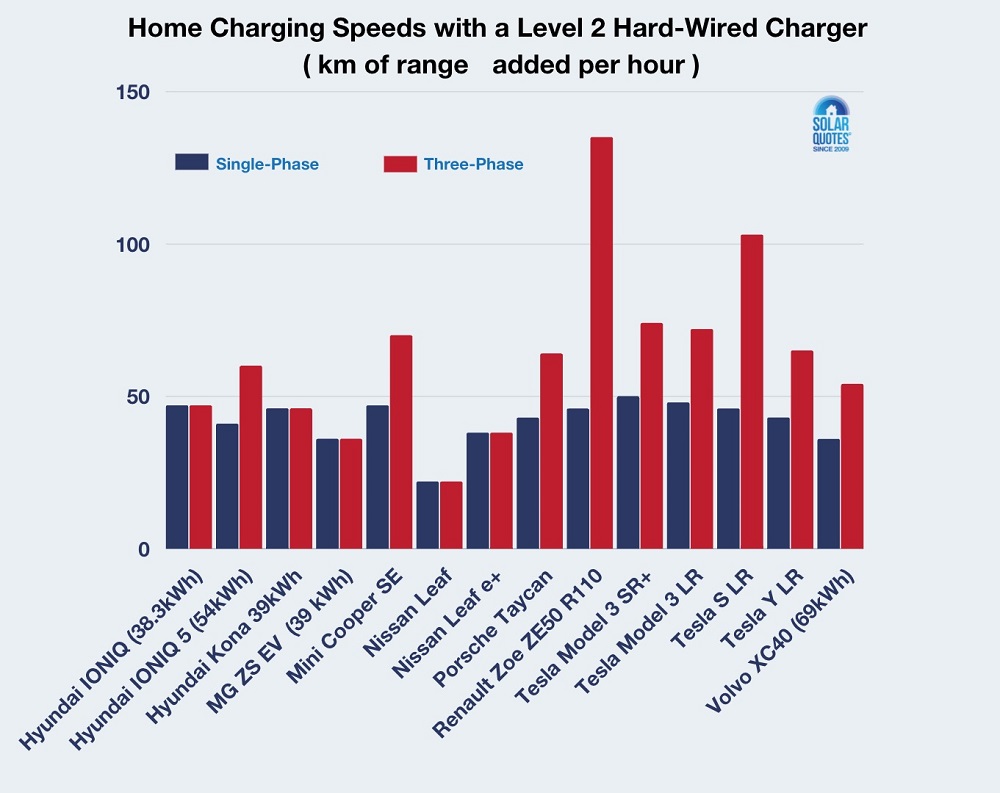
This graph is from my article “How Fast Can I Charge My EV At Home“, which I re-read before writing this article. “I don’t read anybody else, When I write on EV chargers, I plagiarize myself…”
I have a reasonably solid estimate of the price of the 22 kilowatt Wattpilot. Not including installation, you can expect it to set you back around $1,800. You’ll also need a charging cable. Depending on how much work is required, with installation and a cable it could cost you around two and a half thousand dollarydoos.
Wattpilot Go 22J AUS — 22 Kilowatt Portable EV Charger
Unlike most EV chargers, the Wattpilot Go is portable. Whether or not that’s useful will depend on finding a suitable, industrial-style 3-phase socket to plug into. Or an industrial single-phase socket and adaptor lead.
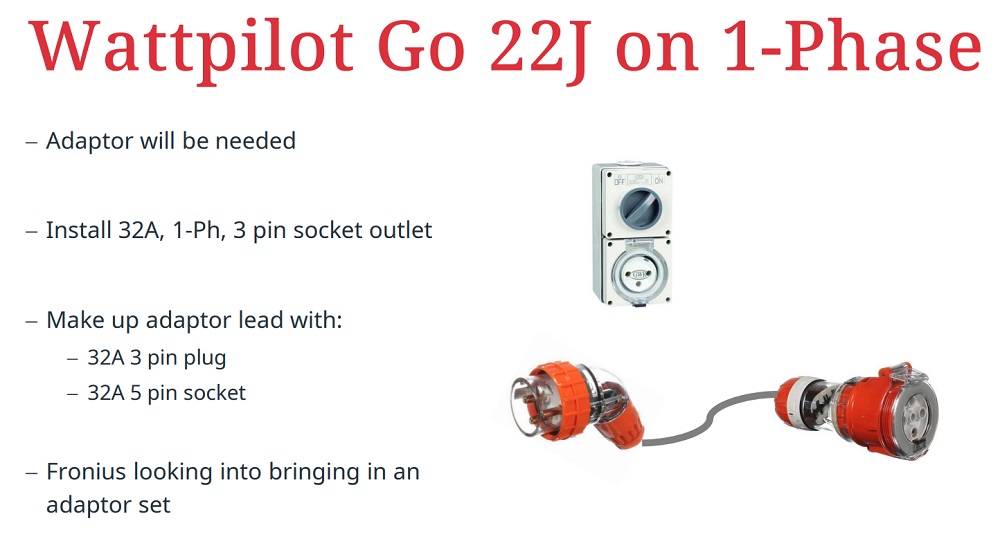
If you have single-phase power, you need an adapter to plug in the Wattpilot Go. Fronius doesn’t currently produce their own adapter but may in the future. Slide: Fronius
In theory, buying just one portable Wattpilot lets you charge at home, at work, at your parents’, and sneakily at your neighbour’s when they’re on holiday. Just note that installing the correct socket will cost several hundred dollars. This can also result in uncomfortable questions if you have one installed in your neighbour’s driveway without their permission.
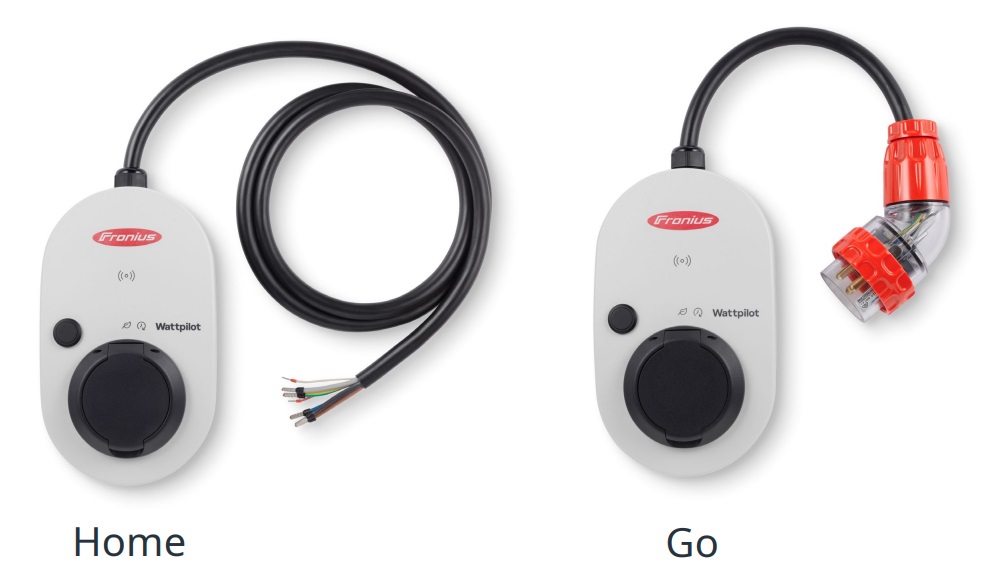
The home versions are hardwired, while the Go version gets to go. On both of them, the large dark circle is the socket cover, while the small dark circle is a button to adjust the charge rate. Image: Fronius
Size
The Wattpilot is pretty small. Its dimensions and weight are:
- Length: 25.1 cm
- Width: 14.6 cm
- Depth: 9.6 cm
- Weight: 1.3 kg (11 kW), 1.6 kg (22 kW)
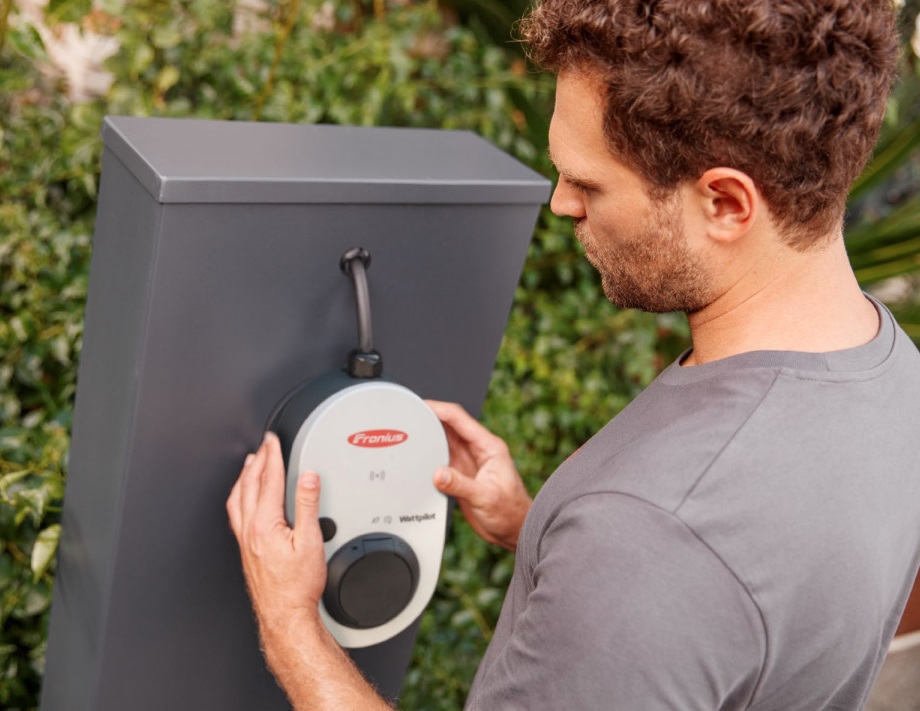
Here’s one of the few pictures provided by Fronius showing how small it is. As small size is important for the portable version, you’d think they’d make a bigger deal out of it. All three versions have identical dimensions. Image: Fronius
Ingress Protection
The Wattpilot’s Ingress Protection rating is IP555. This allows it to be installed outside. When the charging cable is connected, Ingress Protection rating drops to IP44. This means it should be safe to use when it’s raining, but don’t go hosing it down when it’s in use. Or any other time, for that matter. It’s bad luck to hose EV chargers no matter what their IP rating.
Not Included: A Charging Cable
It doesn’t come with a cable that connects the charger to the vehicle. You’ll have to get a ‘Type 2 to Type 2’ cable yourself and they start at $250. If you have a 22 kW Wattpilot, ensure it’s a 22 kW, 3-phase cable. A 5-metre cable weighs around 2.4 kg, which is more than the Wattpilot Go.
Included: 1 ID Chip
Every Wattpilot comes with a little plastic fob that contains an RFID chip. You can put it on your keyring and use it to unlock the Wattpilot so others can’t use it. Up to 10 different chips can be used with a single Wattpilot, but if you want more one, you’ll have to order them. Many people won’t bother with this feature, as it’s unlikely strangers will drive up to your charger and steal electricity. Despite this, I think it should come with two chips, as most cars have more than one main driver.
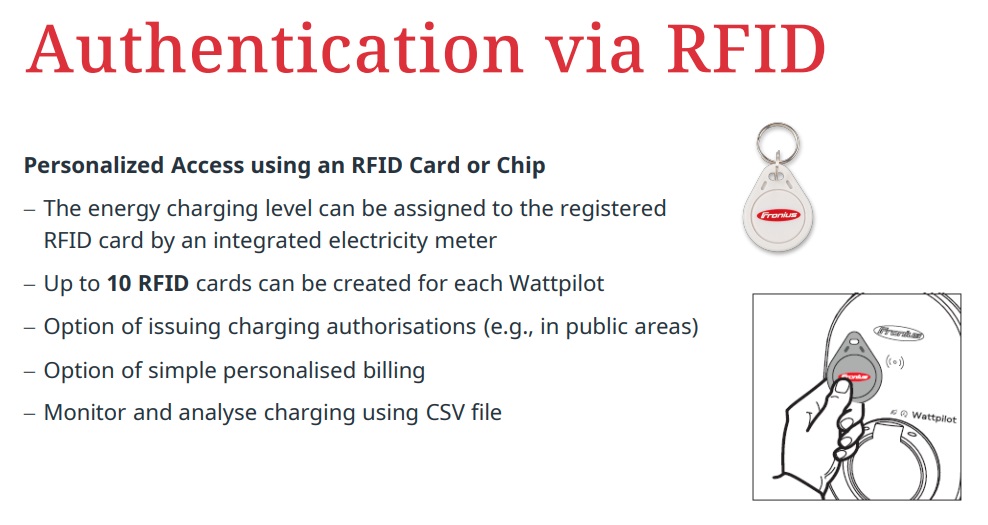
Slide: Fronius
Fronius Wattpilot Smart Features
The Wattpilot has some “smart” features, but they can only be used with a Fronius solar inverter and smart meter. It can work with older Fronius inverters, so it’s not necessary to have the latest GEN24 inverter.
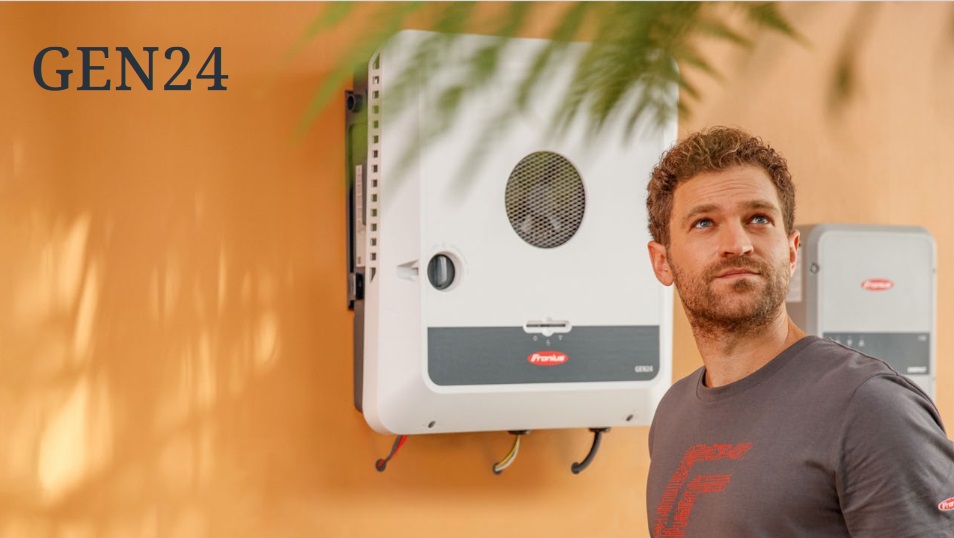
Here is a badly photoshopped picture of a Fronius Gen24 that makes it look bloody enormous. What they did get right is the wistful sadness in the eyes of the permed man as he realizes that, unlike earlier models, the fan is much slower and quieter and no longer doubles as a hair dryer. Image: Fronius
You will also need an internet connection, because the Wattpilot comms are entirely wireless.
If you are not going to make use of any of the smart features, you could get a cheaper dumb EV charger. But if a Fronius Wattpilot is what you want, don’t let me stop you.
I’ll briefly cover two of its smart features:
- PV surplus charging, and…
- Scheduling.
It, of course, has an app. Since we’re almost at the point where sausages at the supermarket have an app, I probably don’t need to mention this.
PV Surplus Charging
With a Fronius inverter and smart meter, the Wattpilot allows PV surplus charging. This will charge your EV with your excess solar electricity.
It’s not perfect, as it requires your solar power system to be exporting at least 1.38 kW before it activates. But it’s a lot more perfect than some other 3-phase chargers that have a minimum charging power closer to 4 kW.
The Fronius cleverly switches to 1-phase charging below 4.14 kW so you can take advantage of surplus solar power down to 1.38 kW.
Without this feature, 3-phase chargers would not be able to use the light green area in the slide below.
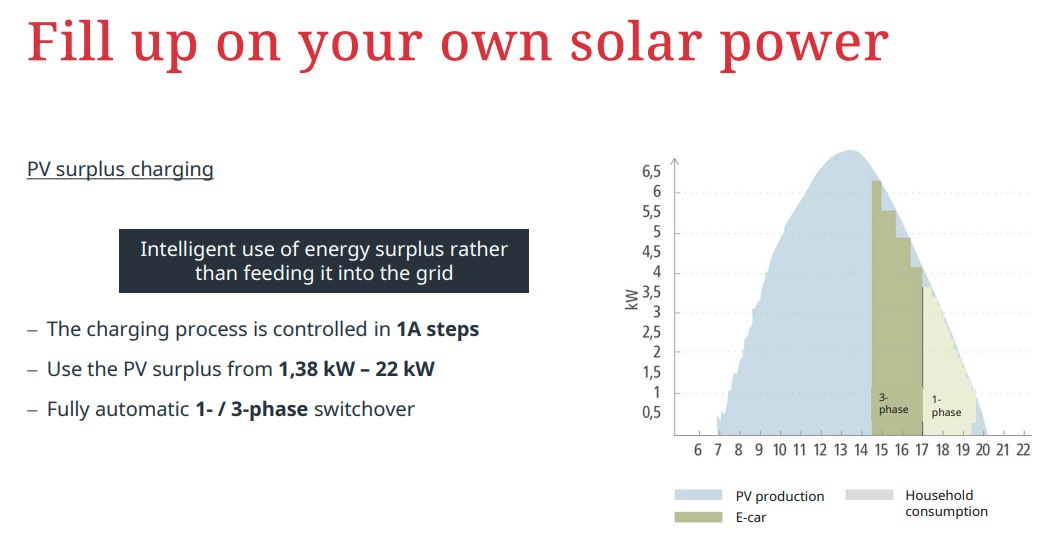
Note those crazy Austrians like to use commas instead of decimal points, so that’s 1.38 kW. Slide: Fronius
Scheduling
In Europe, the Wattpilot can automatically take advantage of some dynamic electricity tariffs, and for example, charge when electricity is below a certain price, or negative.
This feature is not available as a Fronius-supported feature in Australia, but you could use the ChargeHQ6 app with Amber Electric to achieve the same outcome. Or if you are on a standard time-of-use tariff, you can manually schedule charging to be at off-peak or super-off-peak times via the app.
I don’t see the point of the 11 kW version
Anyone saving a few bucks buying the 11 kW variant is likely to be disappointed.
If you have single-phase, and buy the 11J you’ll be really pissed off that your 3.68 charge rate is not really better than a 15A socket.
If you have 3-phase, you’ll be sad when you buy a future EV that can AC charge at more than 11 kW but is limited by the charger.
If you want to buy a Wattpilot – buy the 22J.
OCPP Compatible
The Wattpilot is OCPP compatible. That’s good news if third-party apps or devices want to talk to it to control and coordinate charging.
A Longer Warranty Is Warranted
I’d expect an EV charger made by Fronius to be reliable, but Fronius seems to have less confidence in their work than I do. They only give a two-year warranty. I understand EV chargers are fairly new, but if you can’t trust Austrians to make reliable electronics, who can you trust7?
If Fronius isn’t prepared to beat their competition with at least a five-year warranty, they should go back to the drawing board and come up with a design they’re confident will last. If they’re not willing to do that, they should petition to change their country’s name to “Fake Austria” if it’s not going to live up to its reputation for quality manufacturing.
This post was updated on 29 September 2022 to a) explain that the 11 kW version can only charge at a maximum of 3.68 kW with a single-phase supply and b) add that the Wattpilot has OCPP compatibility.
Footnotes
- Finn seems to think this is important ↩
- In my opinion! ↩
- Finn is planning on writing about their threats soon. ↩
- I’m calling the Wattpilot an EV charger because that’s what everyone seems to call them. But the actual charger is in the car itself. Wattpilots and other home EV chargers are actually “Electric Vehicle Supply Equipment” and not chargers at all. Their purpose is to assist the onboard charger in the vehicle. But to avoid confusion — and also because I could not be arsed writing “Electric Vehicle Supply Equipment” throughout the article — I’m calling them chargers. ↩
- Older versions sold in Europe have an IP rating of IP45. ↩
- But only if/when CHarge HQ integrates with the Wattpilot ↩
- There’s a reason why Terminators have Austrian accents. ↩

 RSS - Posts
RSS - Posts



Very interesting article – and next time I am in Europe I may choose not to visit Austria for my personal safety – I am terrified of Terminators!!
Since I have a recent 3-phase power and Fronius inverter and 9.2kw of well-sited panels and only use some of that, often only a small amount and I want to buy an EV in the next couple of years, I will be a candidate for this. I don’t need it to be mobile and have the space on the existing board beside the Fronius in my shed. I have a smart meter also and wifi.
I would prefer a longer warranty but surely the expected service life of such an item would be somewhat longer than this so it is protected by Australian consumer law for a reasonable service time?
Yes – you would be protected by Australian Consumer Law which says the equipment must be of reasonable quality and durability. One of the factors in determining what’s reasonable is the price. So if your Wattpilot fails after 3 years, you’d have a good argument that a reasonable person would expect an $1,800 charger to last more than 3 years.
The nice thing about the manufacturer’s warranty being explicitly longer is that there is no argument to be had. Arguments are unpleasant. I’ve just been through this with Apple ($1000 phone failed after 3 years), and Wotif (cancelled flight didn’t offer a refund). I won both but had to argue hard and escalate.
The real risk with the Fronius lame-ass warranty is actually with the installer (assuming you get the hardware through them). No matter what Fronius says – they have to honour the ACL warranties.
Would love to see Finn/Ronald take a look at the Canadian product Dcbel.
With a V2X car it covers it all; battery, solar direct to car, etc, etc.
Only one model, (large), but it seems it is a window into the future.
https://www.dcbel.energy/r16/
I am worried that many (I think including the above Fronius) do not have OCPP capability. Even if you currently do not need OCPP, I suggest that is the way to go. The reason is 2 fold:
-Ability to track the energy to the car in an Auditable way. This data would be held by the OCPP database (probably the Energy retailer, because they have the most to gain from the ability to disconnect a charger for a short time). This auditable energy supply will be necessary to charge back the charging cost to a Novated lease company, even if you are the supplier of the power from your own solar or supply. Also tradies & people with company cars will need to be reimbursed for power usage.
-The ability to aggregate EV chargers as a Load shedding ´generator´. This ability will be likely to be managed by your energy supplier, in exchange for a discounted EV charging rate.
I feel that EV chargers will need to be externally controllable to alleviate energy shortages such as happened in June-July. Most of these critical times are fairly short, so will not have much noticeable effect on the vehicle charging. (I guess the power suppliers would have various rates depending on the customers’ requirements: in my case, if the car was off for 2 hours it might not worry me, but a Doctor, for instance, may have different requirements!)
FYI, I am currently evaluating a ZJBeny OCPP EV Charger (as a consumer).
I agree. OCPP may become very important in the near future to co-ordinate EV charging with the grid, solar and other appliances all at the same time.
I got a Delta AC Max specifically because it was OCPP compatible.
Our regularly updated EV Charger Comparison Table shows which chargers have OCPP. Fronius Wattpilot is listed as “TBC” which is better than a hard ‘No’.
Update: Wattpilot is OCPP 1.6 J compatible:
I’m having a 32 A plug installed, three-phase. Is there a 32 A Level 3 charge cable out there?.vIm having the 32amp plug installed to futureproof my charging capabilities.
Hi Hans, To charge your car from a 32A, three-phase socket, you need an intermediate device. You can’t just go from the socket direct to the car.
If you have a Tesla, and their mobile connector you can buy a custom tail like this:
https://evchargers.com.au/product/varplug-to-mobile-connector-gen2/
That will charge at 32A single phase (7 kW).
If you want to charge at 32A 3 phase (up to 22 kW) you’ll need a portable 3-phase charger such as the Wattpilot Go, or something like this:
https://www.evolutionaustralia.com.au/product-page/giger-portable-electric-car-charger-3-phase
And that’s Level 2, not Level 3. Level 3 is fast DC charging
My EV Charging 101 explains all this in detail.
Hope That Helps,
Finn
On my ZJBeny EV charger I have installed a 6mm flex & 32A Plug to plug in my Single Phase 32A socket. It is possible to get a 6mm 3 phase flex (heavy rubber usually) then have an electrician wire it for you. The cable needs to be installed with a stress-relief gland at the EVSE.
You need to understand that if you want your charger to be ´smart´ with the ability to use excess PV power, that will need to be wired & configured by a sparky too.
In my opinion, it is best to permanently wire the EVSE. The cost & availability of heavy flex + the 32A plug mean it is probably cheaper to bypass the 32A socket & fit a blanking cover. I like to have a power disconnect switch at the EVSE anyway.
Very timely article for me, I have been talking to a local supplier about V2H charging for a future EV and this was suggested.
Your very readable article didn’t mention V2H or V2G options with this ‘Charger’. Is that because there really isn’t any EV options yet, or because it won’t do it?, or some other reason I can’t think of?
I’m afraid the Wattpilot doesn’t support V2G or V2H. There are no good options for V2G and V2H available with only a limited number of vehicles able to support them and bi-directional chargers are very expensive at the moment. There’s also no real support at the moment from network operators. Hopefully this will all change before too long.
I recently bought an EV and was considering installing a charger but have found so far over 5 months that the “trickle” charge from an ordinary 13 amp power point is more than we need to enable our daily travel of ~100km. The car also has a timer which you can set to charge when solar power is optimal (horses for courses – we are at home during the day). Our shopping centre has free chargers for any booster charge so the need for a charger has to be assessed/ascertained first?
I had also contacted solar quotes for referrals for quotes to install a home battery. One supplier advised against it just now because in the next 12-18 months he understood that 2 way chargers would be available for EVs enabling the EV to be your home battery (and bigger than any battery currently available) – I wonder if SQ has any knowledge or advice on these?
Hi,
I will put my 2c worth on this!
I have used a 10A portable EVSE up till now. The issue comes when you need to return home (relatively flat) then leave soon after again. For this reason I feel it is worth installing a 32A single phase EVSE. Also with a ´smart´ EVSE, one can utilise the excess PV during the day.
One thing rarely mentioned about 10A portable chargers is the stress on the 240v power socket. occasionally the EVSE gets plugged & unplugged, & I have seen 15A (or 10A) sockets overheat. That is why you should never use an extension lead!. (Even at 10A, the leads to the EVSE get warm )
When I travel, I carry a 10A>15A adaptor cable so if stuck, I can charge from a 10A powerpoint, but I make sure there is no other load on the circuit, & keep an eye on the leads & sockets re heat build up.
the intermediate device between a mains outlet and the EV contains 50usd worth of electronics. I do not see why these have to be priced so extremely expensive. The smarts make use of an EV feature that allows to control the charge current. The pilot signal to the EV needs to be controlled in duty cycle according to the common communication standard. that`s all, a relay with drive circuitry. The rest is the cost of the special plugs.
Finn has had a Mini EV for some time now. Does he still like it?
It’s a great city car (<200km range). Very well built (feels more solid than the Tesla). Fun to drive. Software however is hopeless. App is useless. And if you take it to BMW for scheduled 'servicing' - they are a complete rip-off. They literally charge you hundreds of dollars to do stuff like 'check seatbelts work', 'check horn function'! LOL
The component cost is only a small part of any electronic system. I have worked in an electronics development company. Most of the cost comes in the design, development, testing, certification, warranty, spares,production setup, training and product support, then there is the wholesale margin, transport, retailer margin etc.I am not surprised by the cost at all but would expect eventual economies of scale and competition to drive the cost down further..
What they sell as a charger is just a glorified switch. The AC charger effectively resides inside the EV. Only a DC charger can be called a charger as it takes care of the charging of EV the battery, assisted by CANbus communication to the vehicle.
Yes – please see footnote #3
I don’t agree pushing for longer warranties and manufacturers trying to one up each other in this aspect.
This is why you have ridiculous warranties on panels now as long as 40 years.
In what world does it make sense to offer even a 25 year warranty on a $200 product that is sitting outside in the elements, while a $70,000 European manufactured generator will give you 12 month warranty.
The solution to sell products is to offer reliable products that will be backed by the manufacturer. Increasing warranty period as a measure to increase sales is not something I would encourage.
So you disagree that 2 years is an unreasonably short warranty for an $1,800 box of electronics?
Even the ZJBeny EVSE has a 3 year warranty. It is about 1/2 the price of the Fronius…
The ZJBeny does all the functions that the Fronius does. The monitoring is performed by Current clamps & an RS485 connector to the EVSE. The OPCPP function is Wifi back to the internet router (if the option is included).
The ZJBeny retail product is similar to what was supplied on the first Tesla EV chargers. (Physically the same, but the control firmware/software has been upgraded in the retail product).
A near-neighbour of mine (Hello Greg!) is getting the ZJBeny – I can’t wait to have a good look.
It’s an appliance. A $3000 Samsung TV has a 12 month warranty. So 2 year warranty on an $1800 appliance is not unreasonable. I’m fully aware ACL can override this.
ZJBeny offers a longer warranty yet doesn’t have an Australian office. I would rather a European made product with two year warranty than something that has an extra year from a manufacturer with no Australian presence and frankly is more likely to be of poorer quality.
Seems expensive compared to a Zappi which does much the same thing but is not linked to any proprietary inverter. The Fronius does have the RFID lockout but that seems totally unnecessary for a residential situation. Might be handy in a work carpark but I think there are better solutions than RFID.
And not offering a tethered version seems odd.
FYI – It’s not actually made by Fronius. It’s a re-badged ‘go-e’ which is another Austrian manufacturer
https://go-e.com/en/products/go-e-charger-gemini-flex
https://go-e.com/en/products/go-e-charger-gemini
I like the idea of it being portable. No need to find a public EV charger. Just a 32A power outlet which you can find on the PlugShare Map
https://www.plugshare.com/map/australia
Hi. Great article with some good laughs. Can you please review the SMA EV charger? I see that in Australia it has 5 years warranty and it’s IP65 rated. Thanks
Great review – very helpful, thank you! A couple of questions:
1. The Australian datasheet for the Wattpilot indicates that it has an RCD built-in (20 mA AC, 6 mA DC ) but there is also a footnote that “An additional 30 mA AC residual current circuit breaker and an automatic circuit breaker must be connected upstream”. Is this true? If so, why?
2. Are the current clamps and monitoring hardware included with the Wattpilot?
3. If you already have CT clamps fitted as part of your inverter (in my case Solar Edge) could these also be used for the Wattpilot or are these things brand-specific?
Fronius out of the box Warranty is 2 years but once the device is registered with Solar.web then 5 years of extended warranty is applied automatically at no extra cost to total 7 years. The first 2 years covers materials, labour and shipping both ways. The next 5 years covers materials only. There is also a paid option to extend 2 years’ full cover warranty by another 3 years to a total of 5 years.
https://www.fronius.com/en/solar-energy/installers-partners/service-support/warranty-models
SMA EV Charger comes with 5 years full warranty and if you register the device online with Sunny Portal then an additional 5-year full warranty gets added to total 10 years.
Glad to hear there is a decent warranty on the SMA EV charger. I’ve been disappointed in what I’ve seen offered so far.
Will we be hearing about Finn’s “long ‘legal’ letter” from MyEnergi any time soon? I’m in the market for a home EVSE installation, and the Wattpilot and Zappi are the current top contenders. If the Wattpilot’s relatively short warranty is setting off alarm bells, and Finn has concerns about the longevity of the Zappi, it might be back to the drawing board.
I’m in the same boat as you with Zappi and Wattpilot the top contenders. Finn’s woes have put me off Zappi. Now my solar installer has given me the bad news on the Wattpilot. The minimum setup looks to be a Wattpilot, a Fronius Smart Meter and a Fronius Data Manager 2.0 and of course the charge cable which is not included. There is also an extra RCD which needs to be installed for which was quoted $450. There might also be a cost for the app. All up, the price is likely to be well over $3k. Not good news. Fronius seems to have gone out of their way to make their offering as unattractive as possible…
Have you considered one of these OCPP-compatible chargers with the ChargeHQ app?
ABB Terra AC
Delta AC Max
KEBA KeContact P30 x-series
MG ChargeHub
Ocular IQ
Schneider EVlink Smart Wallbox
Wallbox Pulsar Plus
Thanks for the list of OCPP-compatible chargers. What makes me hesitant to take this route is ChargeHQ. Yes, the service is currently free. But relying it remaining to be free (which even they say they “are exploring possible business models”), or at the very least continuing to exist at all, is a red flag.
Additionally, ChargeHQ setup with Fronius systems requires access to a Solarweb account (https://chargehq.net/kb/fronius-inverter-setup). Not an issue at the moment but, again, Fronius could change or remove access to this service in the future. I’m willing to sacrifice “cloud” and “smart” for reliability and availability.
Have you had any experience with the OpenEVSE units (https://store.openevse.com/collections/all-products)? If so, can you speak to the regulations around assembly/installation in Australia?
P.S. looking forward to hearing about your interactions with MyEnergi
Haven’t considered them yet, but will definitely be looking into them. I know you went with Delta after your Zappi – I’m looking forward to your review of Delta when you you get to it.
Hi Finn,
Are all of these OCPP compatible chargers ‘smart’? I am still considering a Zappi as I would like to utilize excess solar but I’m unsure which others to consider.
Thanks
Jasmine
You’re right about the requirements. I’m fortunate enough to have a PV system with these exact components, but it might as well have been dumb luck. So on top of the “from $2690” some installers are quoting (https://perthsolarwarehouse.com.au/product/ev-chargers/) and the addition of a Type 2 cable, $3000 is the absolute minimum it would cost to have a Fronius-based solar-aware charging system.
From my research into the Wattpilot, it determines excess solar production by communicating with the DataManager API; not CT clamps like the Zappi. So if there is ever a communications issue between the two—wifi/ethernet disconnection, network switch failure, DataManager failure (I’ve managed to brick mine in the past with a simple firmware update; replaced under warranty, but leaving me without export data for 3 weeks)—you lose the primary benefit of installing a Wattpilot in the first place.
@Ray, the Fronius Wattpilot has RCD protection built in so not sure why your sparky wants to install an additional RCD for $450. Some of the cheaper EVSE units have no RCD protection built in so they do require this $450 RCD circuit added.
Great article. I was sold on the ‘Home’, as I can only ever see my self charging at home, but now after reading this article I can’t see any disadvantages to having the mobile ‘Go’ option, even if I never use its potable options. Did I miss that in the article? Does the ‘Home’ do anything that the ‘Go’ doesn’t do? Or just it just look a little nicer hardwired into the wall?
We have just had the Fronius Wattpilot Go 22kW installed in our home and It’s working well.
FYI – if wondering – the Kia EV6 has a max AC charge rate of 11kW (15A*240V*3ph).
The unit has a button which allows for your two main charge profiles:
– One press: The charge profile is in eco mode (excess PV only)
– Two presses: the charge profile is in next trip (max charge rate)
There are settings within the gui for next trip which lets you designate km, kWh or time targets, after which it will leave next trip mode.
You can also manually set the charge rate.
For Eco mode, the unit will wait 2 mins after a change in ‘surplus PV available’ before making a decision on changing the charge rate. This makes it tolerant to cloud shading. The minimum time between changes in charge rate is 10 mins.
It also has a menu so that you can prioritize home battery charging over EV charging, if your home battery is below xx%.
I appreciate your report. It’s good to get user’s experiences and I hope it all works well for many years to come. Fronius has a good reputation so I expect good durability and performance from their EV chargers.
If you’d like to leave a review of the charger you can do that here:
https://www.solarquotes.com.au/quote/evcharger_feedback.php
Thanks for the user review – very informative.
I’m very new to solar and EV charging. My solar panels were installed in December and I’ve shortlisted a Zappi installation as my next step. Maybe a Wattpilot Go would be a better option since I’m using a Fronius inverter.
In ECO mode, can the Wattpilot stop charging when there isn’t enough solar energy generated or will it always switch to grid power?
Hi Kevin in eco mode in Australia the Wattpilot will only charge if surplus solar electricity is available. In Europe it can charge the vehicle when electricity prices are cheap, but that feature isn’t available here yet.
Hi Kevin
If I may make a suggestion, as someone who has been in the same situation, forget the expensive “smart” chargers. You will pay through the nose for those. After much procrastination and weighing up options, I went with the standard Tesla wall charger (3-ph) and the FREE ChargeHQ app. It integrates our Model3 with our inverter (Solar Edge) and controls the solar optimized charging according our pre-set thresholds. It works brilliantly and the Tesla dumb charger is so cheap in comparision ($750). I can’t believe no one is making a big deal of this app! Good luck!
Hi there,
I have a Fronius 15kw 3-phase Symo, and Solar Analytics.
Will “smart” charging (ie. only charge with surplus) work with this set up?
Or should I buy a Zappi?
A Zappi will certainly work – if all you want to do is solar smart charging. But think about whether you want to do more than that it the future as the Zappi is not OCPP compatible.
ChargeHQ will interface with Solar Analytics and the hardware here and is more future proof IMO:
https://chargehq.net/kb/is-my-setup-compatible
Hi. I’m about to take receipt of my 2 years ago ordered Bmw Ix and stumbled across your excellent review. We’re on 2 phase (go figure!) and recently had fronius primo and Tesla battery installed on each phase. It sounds like the 22kw watt pilot might suit, but question: how far away from the inverter can the watt pilot be installed? I’m planning about 20 m away in the shed where I park my car. Tia
Hi Irwin,
You obviously need a decent sized cable in your garage to power the charger but seeing as the Wattpilot relies on an internet connection, you’ll need to have a good WiFi signal for it, so that may need a repeater/booster depending on the strength of your home network.
If you have two phase then I would be surprised if the charger will cope with more than one.
I have a 2020 Mitsubishi Outlander. Chademo for DC charging and Type 1 for AC. The 10A/2.2kw “charger”supplied with the car takes about 6-7 hours to go from 0-100% charge. I’ve got it on a timer from 8am to 4pm and all going well have spare solar to get it charged. On a cloudy day however it will draw power from my Powerwall which is annoying and I have to manually intervene. So a smart charger might be nice and I’ve got Fronius inverters so a Watt pilot might be a good fit. However, if I have the facts right; Type 1 is single phase and the Outlander on board charger is limited to 3.7kW. So an EVSE would only reduce my charge time to 4 hours and a bit. Paying a few thousand dollars for the EVSE, new wiring, plugs and cables doesn’t seem to make sense. In terms of getting the house ready for the future I am still waiting for someone to get off their arse and issue an approval for V2H/V2G equipment. I think I’m right in saying if I had that I wouldn’t need a level 2 charger?
Mark – the Outlander, as a PHEV, has a comparatively small battery (~14kWh) compared to a fully electric car. You are indeed correct that a standard powerpoint charge is all you’ll ever need for that car and paying thousands for a level 2 EVSE is overkill.
Great write up. Thank you SolarQuotes.
I’ve read all the documentation I can find, but I can’t get an answer regarding
the Wattpilot go 22.
It says that you need a compatible Fronius inverter + Smart meter.
I’m using a Fronius Primo, which isn’t specifically listed on the compatible inverters.
Do you know whether I can still use the smart PV charging with a Wattpilot Go 22 and the Fronius Primo inverter?
Hey Mark – yes, the Fronius Primo is part of the SNAPINverter range, which is directly listed as compatible here on page 13: https://www.fronius.com/~/downloads/Solar%20Energy/Operating%20Instructions/42,0426,0400,EN.pdf
Hello Ron,
This is Chris, from France, and congrats for the nice and comprehensive article. I agree with you that buying an 11-kW version is not worth the shot, especially if you realize that you can’t exceed 3.68 kW from a single-phase mains, whether it is with the Go version or the Home one. It makes sense for the Go version as you cannot draw more than 16 A from a classical outlet in a single-phase configuration but for the Home version, they could have authorized 32 A when the socket is supplied from a dedicated protected line.
This is difficult to understand considering the competitive landscape and the cheap wallboxes capable of 7.4 kW in single-phase applications. After all, these devices do not host power electronics converters per se as all the job is done by the on-board charger (OBC) driven by the Fronius socket. So authorizing 32 A is just a matter of authorization and thicker connecting wires in the cord supplied with the socket.
Anyway, with that in mind, I bought a 22-kW Home version that is normally not distributed in France. And how bitter I was to see that in the apps, the max current in a single-phase mains is also clamped to 16 A (Grid Settings tab). Even if the apps detects the Home version – and mine is supplied from a dedicated 10-mm² cable duly protected – I’m stuck to 3.68 kW! Despite the advertisement where they claim up to 7.4 kW in single-phase, I could not unlock the parameter to higher current. And the French support confirms this which is just unacceptable. I’ve seen they are releasing a new firmware (40) and perhaps this has been accounted for. Otherwise, if it stays like this, it’s a scam! Let me know what you think Ron, thanks!
Cheers,
Christophe
I’m using the Home 22J on single phase and 32A current is not an issue.
Hi Kevin, I checked the apps this morning and the clamp on the phase current has gone! Dunno if there has been a glitch or a recent update but it seems to be ok now. Nevertheless, I think the 22-kW Home is the only model among the four that allows to get at least 7.4 kW from a 1-phase network. The 22-kW GO version will limit the absorbed current to 16 A when connected to a 1-phase E-type outlet and the 11-kW GO or Home are 16 A maximum anyway.
My car, Hyundai Ioniq 38.3, is limited to charge rate of 7 kW. Why do I need to use a 22kw, 3 phase cable with the 22kW WattPilot? I have a much lighter, 7kW cable.
This is my question too – but for an MG4 excite 51kwh, with a max. charge rate of 6.6kw and with an on board charger that can only perform single phase charging.
Brian, I think this line in the article suggests a 7kw cable meets our needs:
“The 22J can charge at 7.3 kW on single-phase and 22kW on 3-phase.”
I recently bought BYD Seal. I have installed the 22kW Wattpilot and have 3 phase charging cable. I still get only just over 7 kW charge. Is there any limitation which prevents the Wattpilot to charge more?
Hi Ilian,
I think the on board AC charger for all the BYDs is only a single phase 7kW device but you’ll need to check that in the manual or with BYD themselves.
Hi there,
I am looking at installing a couple of WattPilot’s at our business. The choice is due to us having a significant PV setup here & being all Fronius. My question is I noted only 2 modes “next trip” and “eco” .
Would the next trip mode be suitable for charging general vehicles off a mix of grid and PV no matter the PV output & does the Next Trip mode require the user to always set a required KM’s to charge to?
Thank you, Juan.
I think you are right. I did some research and apparently most of the EVs are limited to 11 kW at home charging. The BYD seems to be limited to 7kW which for me is really disappointing…just my expectations were different…
I have a WattPilot Go model and was wondering if someone new where I could get hold of an adaptor to allow this to run off a 10amp 3 pin standard plug with 5 pin connector to the WattPilot. Am in South Australia.
Hi Ian,
A competent electrician should be able to coble that together for you but it might need a 10a circuit breaker.
Perhaps buy one of these :
https://www.bcf.com.au/p/ampfibian-mini-indoor-adapter/535271.html?cgid=BCF08024#start=2
And a female 3ph socket to be wired into it.
Unless you’re specifically using the WiFi smarts of the wall pilot it may just be simpler to get a standard EVSE..?
https://www.gumtree.com.au/s-ad/hawthorn-east/other-parts-accessories/portable-10-amp-evse/1322804570